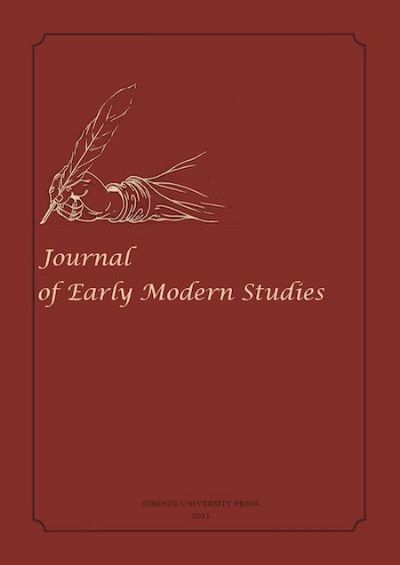We are now inviting contributions for Volume 10 of the Journal of Early Modern Studies, to be released online in 2021.
Edited by Maurizio Ascari and Gilberta Golinelli
The 2021 issue of JEMS aims to cover various inter-related fields within the vast domain of European crime literature, with a particular focus on the British Isles. The literary and cultural phenomena we aim to investigate range from street literature, with its variety of broadsides and chapbooks, to drama (from revenge tragedies to domestic tragedies) and providential fictions, such as John Reynolds’ The Triumphs of Gods Revengeagainst the Crying and Execrable Sinne of Murther (1621-35), including the translation and transnational circulation of crime stories.
While exploring the connection between real crime and the literary imagination at various levels (from street literature to more sophisticated renderings), this issue delves into the ideological import of crime narratives intended as prevention of crime, a form of psychological ‘policing’ that compensated for the absence of organized police forces by reasserting the certainty of mundane and supernatural punishment. At the same time, focusing on the description and the representation/performance of emotions will enable us to analyse early modern criminography with the right lens to highlight its peculiarity and interrogate its multilayered aims. Instead of pivoting mainly on detection, early modern crime narratives revolve around criminal lives and criminal minds, not to mention self-appointed justice seekers, although of course community-based forms of social control were far from absent in early modern Europe. Both on page and on stage, providential fictions are often tragic and proto-melodramatic in tone, and this includes broadsides, which typically climax with a ballad to be sung to the tune of a song, achieving a combination of news circulation and engaging rhetorical/aural effects.
Given the nature of early modern crime literature, we invite papers exploring these and related issues:
History. The relation between historical criminal events and their literary representations. Many early modern crime narratives are part of the vogue of news that was fostered by both the invention of print and the translation/remediation of foreign materials. Being marketed as ‘true stories’ (often soon after the events they recount), in order to exploit the sensational appeal of real criminal cases, these narratives can be regarded as the ancestors of what we label as true crime.
Ideology.The conceptualization of crime in relation to the complementary paradigms of sovereign power (or mundane justice) and of God’s omniscience/omnipotence. Early modern crime is conflated with sin, and in the absence of organized policing detection is correspondingly presented as resulting from the synergy of social surveillance and providence. The emphasis is on coincidence rather than on organized and rational detection. Due to the containment of, and simultaneous fascination with, transgression, criminals are portrayed as both abject and heroic, but we can also interpret these ambivalent portraits as the ‘product’ of gender constrictions and discriminations.
Agency.While criminal agency is often presented as stemming from the devil, early modern crime narratives reveal an increasing ‘psychologisation’ of crime, investigating both the criminal’s motives and the devastating impact of guilt. This interest for the criminal overlaps with the conception of the human the early moderns inherited from classical tragedy, notably with the Aristotelian concept of hamartia.
Emotions.Early modern crime literature appeals to the emotions on various levels and in all its forms, whether the focus is on the plight of victims or on the inner turmoil of offenders and revengers.
Body. The spectacle of the violated/murdered body, of bodily punishment and execution rituals, raises questions on the various meanings and appropriations of a racialized and gendered body, calling our attention to the body as a powerful symbol and rhetorical tool in relation to a set of discourses in which science and medicine conflate with politics and ideology.
Gender: Gender as a method of inquiry has been extremely useful to re-consider the formation of identities, subjectivities, their agency and their access to justice and compensation. Reading the performance and representation of male/female crime and criminals in a gender perspective might illuminate how gender relations and hierarchies were implicated in the construction of systems of power, social norms and national legal system.
Genre. Early modern crime fiction covers a wide spectrum of genres, ranging from domestic tragedies and revenge tragedies to providential fictions, ballads, sermons and other religious texts. Issues of crime and punishment are also central to early modern utopias and utopianspeculations and thus pivotal in those hybridliterary texts in which fictional debates on social norms and justice, on the nature of crime and on capital punishment serve(new) political programmes and the envisioning of alternative forms of government.
Main deadlines:
30th June 2019:
Please send your proposal and working title to the editors (maurizio.ascari@unibo.it; gilberta.golinelli@unibo.it).
20th July 2019
Notification of proposal acceptance.
10th January 2020:
Submission of articles to the editors.
Please note that articles must comply with the editorial norms and must not exceed 12,000 words, including footnotes and bibliography. Articles may include up to 10 images (for publication they need to be submitted in 600 dpi resolution and with publication permit). All articles are published in English. Please be so kind as to have your paper revised by a native speaker.

